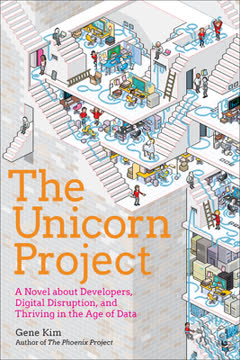Key Takeaways
1. IT Operations is critical to business success and must be integrated with development
"IT is not just a department. IT is a competency that we need to gain as an entire company."
IT is a core business function. Many organizations treat IT as a necessary evil or cost center, but it's actually central to delivering value to customers. IT needs to be tightly integrated with development and business strategy.
DevOps principles bridge the gap. By breaking down silos between development and operations, companies can deliver software faster and more reliably. This requires cultural change, shared ownership, and aligned incentives across teams.
Key DevOps practices:
- Continuous integration and delivery
- Infrastructure as code
- Automated testing and deployment
- Shared metrics and monitoring
- Blameless postmortems
2. Effective change management reduces risk and improves stability
"We need to create a feedback loop that goes all the way back to the earliest parts of product definition, design, and development."
Poorly managed changes cause outages. Many IT incidents stem from changes that weren't properly planned, tested, or communicated. A robust change management process reduces risk.
Balance control and agility. While change control is important, overly bureaucratic processes can stifle innovation. The goal is to enable rapid, frequent changes while maintaining stability.
Elements of effective change management:
- Clear policies and procedures
- Risk assessment and mitigation
- Testing and validation
- Rollback plans
- Post-implementation review
3. Identify and optimize constraints to improve overall system performance
"Improving daily work is even more important than doing daily work."
Find the bottleneck. In any system, there's always a constraint limiting overall throughput. Identifying and optimizing this constraint yields the biggest improvements.
Elevate the constraint. Once identified, focus on maximizing the efficiency of the constraint. This may involve automating tasks, reducing interruptions, or adding capacity.
Steps to optimize constraints:
- Identify the system constraint
- Exploit the constraint (maximize its efficiency)
- Subordinate everything else to the constraint
- Elevate the constraint (increase its capacity)
- Repeat the process for the new constraint
4. Reduce batch sizes and increase deployment frequency to enhance agility
"Features are always a gamble. If you're lucky, ten percent will get the desired benefits. So the faster you can get those features to market and test them, the better off you'll be."
Smaller batches reduce risk. Large, infrequent deployments are inherently riskier and make it harder to isolate and fix issues. Smaller, more frequent deployments allow for faster feedback and iteration.
Continuous delivery enables experimentation. When you can deploy quickly and safely, it becomes possible to run many small experiments to optimize features and business outcomes.
Benefits of smaller batch sizes:
- Faster time to market
- Reduced deployment risk
- Quicker feedback loops
- Improved quality
- Increased ability to pivot
5. Automate processes to reduce errors and increase efficiency
"Get humans out of the deployment business."
Manual processes are error-prone. Humans make mistakes, especially when performing repetitive tasks under pressure. Automation reduces errors and frees up time for higher-value work.
Treat infrastructure as code. By managing infrastructure through version-controlled code, you can ensure consistency across environments and easily reproduce or roll back changes.
Key areas for automation:
- Environment provisioning
- Code deployment
- Testing
- Monitoring and alerting
- Incident response
6. Prioritize based on business value and manage work in progress
"Until code is in production, no value is actually being generated, because it's merely WIP stuck in the system."
Focus on outcomes, not outputs. It's easy to get caught up in activity metrics, but what matters is delivering actual value to the business and customers.
Limit work in progress (WIP). Too much WIP leads to context switching, delays, and reduced quality. By limiting WIP, you can improve flow and reduce cycle times.
Techniques for managing work:
- Kanban boards to visualize workflow
- WIP limits to prevent overloading
- Regular prioritization meetings
- Clear definition of "done"
- Measuring cycle time and throughput
7. Foster a culture of continuous improvement and learning
"Improving daily work is even more important than doing daily work."
Encourage experimentation. Create an environment where it's safe to try new things and learn from failures. This drives innovation and continuous improvement.
Practice makes perfect. Regular drills and simulations help teams prepare for incidents and improve their response capabilities.
Ways to promote learning:
- Blameless postmortems
- Regular retrospectives
- Dedicated time for innovation projects
- Cross-training and skill sharing
- External conference attendance
8. Break down silos and improve communication between departments
"Dev and Ops working together, along with QA and the business, are a super-tribe that can achieve amazing things."
Silos hinder progress. When departments operate in isolation, it leads to misaligned goals, communication breakdowns, and suboptimal outcomes.
Create shared goals and metrics. Align incentives across teams to encourage collaboration and focus on overall business outcomes rather than local optimizations.
Strategies for breaking down silos:
- Cross-functional teams
- Shared on-call responsibilities
- Regular inter-department meetings
- Job rotation programs
- Collaborative tools and platforms
9. Understand and optimize the entire value stream
"You've got to stop thinking like a work center supervisor. You need to think bigger, like a plant manager."
Map the value stream. Understanding the end-to-end process of delivering value to customers helps identify bottlenecks and optimization opportunities.
Optimize for flow. Focus on reducing lead times and improving the efficiency of the entire system, not just individual components.
Steps to optimize the value stream:
- Map the current state
- Identify waste and bottlenecks
- Design the future state
- Implement improvements
- Measure and iterate
10. Balance stability and innovation to drive business growth
"Business agility is not just about raw speed. It's about how good you are at detecting and responding to changes in the market and being able to take larger and more calculated risks."
Stability enables innovation. A stable, well-managed IT infrastructure provides the foundation for rapid experimentation and innovation.
Embrace calculated risks. While stability is important, taking smart risks is necessary for growth. Create systems that allow for safe experimentation and rapid learning.
Strategies for balancing stability and innovation:
- Feature flags for gradual rollouts
- A/B testing frameworks
- Chaos engineering to improve resilience
- Innovation time for employees (e.g., 20% time)
- Regular review of technical debt and modernization needs
Last updated:
FAQ
What's The Phoenix Project about?
- IT and Business Integration: The Phoenix Project by Gene Kim is a novel that delves into the challenges of integrating IT operations with business management. It follows Bill Palmer, who is unexpectedly promoted to VP of IT Operations at Parts Unlimited.
- DevOps Principles: The book introduces key DevOps principles, emphasizing collaboration between development and operations teams to improve efficiency and reduce time to market.
- Crisis Management: Bill navigates various crises, such as network outages and a failed payroll system, which serve as metaphors for larger organizational issues, highlighting the importance of communication and process management.
Why should I read The Phoenix Project?
- Real-World Application: The book provides practical insights into managing IT operations and implementing DevOps practices, valuable for IT professionals, managers, and executives.
- Engaging Storytelling: The novel format makes complex concepts accessible and engaging, allowing readers to relate to the characters and their struggles.
- Cultural Shift: It encourages a cultural shift within organizations, advocating for continuous improvement, learning from failures, and fostering collaboration across departments.
What are the key takeaways of The Phoenix Project?
- Importance of Communication: Effective communication is crucial for successful project management and crisis resolution, ensuring all stakeholders are informed and involved.
- Focus on Flow: Managing work in progress (WIP) is essential to deliver value efficiently, helping organizations identify bottlenecks and improve productivity.
- Continuous Improvement: The book advocates for a culture of continuous improvement, where teams learn from both failures and successes to adapt and enhance their ability to deliver quality products.
What is the "Three Ways" framework in The Phoenix Project?
- First Way - Flow: Focuses on optimizing the flow of work from Development to IT Operations, emphasizing reduced batch sizes and improved delivery speed.
- Second Way - Feedback: Highlights the importance of feedback loops in the development process, encouraging learning from both failures and successes.
- Third Way - Continuous Learning: Promotes a culture of experimentation and learning, emphasizing resilience and adaptability in the face of challenges.
What specific methods or advice does The Phoenix Project offer?
- Drum-Buffer-Rope: A method to manage work flow to the constraint in an organization, ensuring the bottleneck resource is always utilized effectively.
- Kanban Boards: Highlighted as a visual management tool to track work and manage changes, helping teams prioritize tasks and identify potential issues.
- Blameless Postmortems: Conducting blameless postmortems after incidents fosters a culture of learning and improvement, preventing future issues.
What are the best quotes from The Phoenix Project and what do they mean?
- “You can’t improve what you don’t measure.”: Emphasizes the importance of tracking performance metrics to identify areas for improvement.
- “The goal of IT is to support the business.”: Underscores IT's primary purpose within an organization, aligning efforts with business objectives.
- “Every improvement not made at the constraint is an illusion.”: Highlights the need to focus on the bottleneck resource, as improvements elsewhere may not yield meaningful results.
How does The Phoenix Project illustrate the concept of DevOps?
- Collaboration Between Teams: Showcases how breaking down silos between development and operations teams can streamline processes and reduce delivery time.
- Cultural Change: Emphasizes the need for a cultural shift to embrace DevOps principles, promoting continuous improvement and shared responsibility.
- Feedback Loops: Illustrates the importance of establishing feedback loops to quickly identify and address issues, enhancing responsiveness to changing requirements.
What challenges does Bill Palmer face in The Phoenix Project?
- Crisis Management: Bill manages multiple crises, including network outages and a failed payroll system, while implementing changes to improve IT operations.
- Corporate Politics: Faces political challenges with various stakeholders, complicating efforts to drive change and gain support for initiatives.
- Resource Constraints: Struggles with limited resources and the need to prioritize projects effectively, balancing ongoing operations with urgent projects like Phoenix.
How does The Phoenix Project address the issue of unplanned work?
- Definition of Unplanned Work: Defined as work that disrupts planned activities, such as incidents and emergencies, leading to chaos within an organization.
- Impact on Productivity: Unplanned work consumes resources and prevents teams from focusing on primary objectives, emphasizing the need to minimize it.
- Strategies for Management: Suggests implementing processes and tools, like incident response protocols, to better manage unplanned work and reduce its impact.
What role does Brent play in The Phoenix Project?
- Key Resource: Brent is a highly skilled engineer, critical to the IT Operations team, but his expertise creates a bottleneck as others rely on him.
- Impact on Workload: His involvement in various projects leads to increased unplanned work, disrupting planned activities and highlighting over-reliance on a single individual.
- Need for Knowledge Transfer: Emphasizes the importance of knowledge transfer and documentation to prevent dependency on Brent, reducing risk of a single point of failure.
How does The Phoenix Project depict the relationship between IT and business?
- Alignment of Goals: Illustrates the need for IT to align its objectives with business goals, ensuring technology supports overall performance and customer satisfaction.
- Communication and Collaboration: Emphasizes effective communication and collaboration between IT and business leaders for successful outcomes.
- Shared Responsibility: Highlights shared responsibility for outcomes between IT and business units, working together to deliver projects successfully.
What lessons can be learned from The Phoenix Project?
- Value of Process Improvement: Underscores the importance of continuously improving processes to enhance efficiency and effectiveness.
- Importance of Teamwork: Highlights the significance of teamwork and collaboration in achieving organizational goals, fostering a culture of cooperation.
- Need for Adaptability: Teaches that organizations must be adaptable and responsive to change, essential for long-term success in a fast-paced environment.
Review Summary
The Phoenix Project receives mixed reviews, with many praising its realistic portrayal of IT challenges and its educational value for understanding DevOps principles. Readers appreciate the engaging storytelling format, though some criticize the writing quality and character development. IT professionals find the book relatable and insightful, while non-IT readers may struggle with the technical content. Critics argue it oversimplifies complex issues and promotes unrealistic solutions. Despite its flaws, many readers find the book compelling and valuable for learning about IT operations and management.
The Phoenix Project Series
Similar Books










Download PDF
Download EPUB
.epub digital book format is ideal for reading ebooks on phones, tablets, and e-readers.








